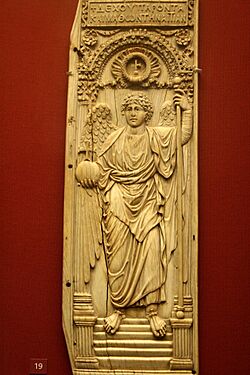Archangel ivory facts for kids
Quick facts for kids Archangel ivory |
|
|---|---|

on display in the museum
|
|
| Material | ivory |
| Size | 428 x 143 mm and 9 mm thick |
| Created | AD 525-550 |
| Place | Constantinople |
| Present location | Room 41 of the British Museum, London |
The Archangel ivory is a very old and special piece of art. It is the biggest surviving panel made from ivory during the Byzantine Empire. Today, you can see it at the British Museum in London. This artwork was made in the early 500s AD. It shows an archangel, which is a high-ranking angel, holding a special staff called a sceptre and a ball with a cross on top, known as an imperial orb.
Contents
What is the Archangel Ivory?
The Archangel ivory is a famous artwork from the early 6th century. It is the largest single piece of carved Byzantine ivory that still exists. It measures about 42.9 centimeters tall and 14.3 centimeters wide. That's roughly the size of a large ruler!
Who is the Archangel?
The archangel shown in the carving is usually thought to be Saint Michael. He is a very important archangel in many religions. Experts believe this ivory panel was once part of a larger artwork called a diptych. A diptych is like a book with two hinged panels.
The other half of this diptych is now lost. It might have shown Emperor Justinian, who ruled the Byzantine Empire from 527 to 565 AD. If so, the archangel would have been offering symbols of imperial power to the emperor. This would show that the emperor's power came from God.
What Does it Look Like?
This ivory panel is very detailed and skillfully made. It is believed to have been created in the emperor's own workshops in Constantinople. These workshops were known for making very high-quality art. Another famous ivory from that time, the Barberini ivory, also came from these workshops.
A Mix of Styles
The archangel looks very much like statues from ancient Greece and Rome. He wears clothes that look Greek or Roman. His face is young, and his body shape follows the old Greek ideas of perfect beauty.
However, the way the space is shown is more typical of Byzantine art. For example, the archangel's feet are on the top step of a staircase. But his arms and wings seem to be in front of the columns behind him. Also, his feet don't look like they are firmly planted on the steps. This creates a slightly dreamlike or floating feeling.
What Does the Writing Say?
At the very top of the ivory panel, there is some writing in ancient Greek. People have translated this writing in different ways.
One translation is: "Receive this suppliant, despite his sinfulness." A "suppliant" is someone who asks for help or favors. If this translation is correct, it might show Emperor Justinian being humble. He would be asking for God's help even though he knew he wasn't perfect.
Another idea is that the writing was just the beginning of a longer message. This message would have continued on the lost second panel of the diptych. If so, it might have read: "Receive these gifts, and having learned the cause..." This would suggest the archangel was presenting gifts or a message to the emperor.

